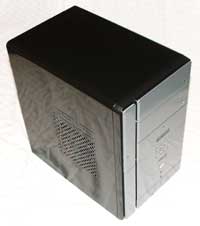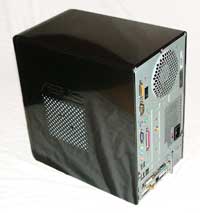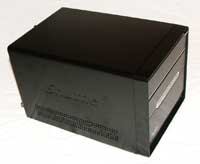Close Encounters of the Small Kind
by Jarred Walton on December 8, 2004 12:05 AM EST- Posted in
- Cases/Cooling/PSUs
Close Encounters
Writing for AnandTech puts me in something of a unique position. Few brick and mortar stores carry a large selection of SFF cases, and looking at pictures online doesn't always tell the whole story. With AnandTech, we have a large number of SFF units, many still waiting to be reviewed. (A SFF roundup will be coming soon, in case you were wondering. This is just a preface to the roundup.) The plan wasn't for me to begin using one of these cases as my own system initially, but system instabilities with one of my own computers caused me to change my mind. While I RMA the motherboard that is apparently causing problems and wait for its return, I decided to adopt one of the SFF cases for my own use - but which one?Understanding that aesthetics are a completely personal view, I checked out all of the cases. They all look pretty good, depending on your own taste - what I hate, someone is bound to love, and what I like, some will think is boring. In the end, I built two of the units just for purposes of a "test drive" and I picked what are basically the two extremes of the SFF genre.
 Click to enlarge. |
 Click to enlarge. |
On the one hand, we have the ASUS T2-P Deluxe. Depending on your point of view, it may not even qualify as a true SFF design. Featuring two CD/DVD slots, a 3.5" floppy bay - the floppy drive is actually included with the case - and an internal 3.5" HDD, not to mention a ton of other extras, the ASUS SFF includes everything and the kitchen sink. (The manual states that a CD/DVD drive is also included, but it was not present in this unit. This is possibly due to the fact that this unit was sent for review purposes, but it could also just be an error in the manual. We will try to get the official word from ASUS for the formal review; for now, it has a spare DVD-ROM in it.) Audio, fast Ethernet, USB2.0 and IEEE 1394a Firewire are pretty much standard features on any SFF. Add to that a six-in-one flash card reader, gigabit Ethernet, a radio tuner and antenna, integrated graphics, 802.11G wireless networking, and even serial and parallel ports, and you have a package that leaves little to be desired in terms of features. ASUS does limit your expansion options in one area, however. Many of the extras are included on a PCI add-in card, so your expansion card options are limited to adding an AGP graphics card.
 Click to enlarge. |
 Click to enlarge. |
The other unit is the latest from Shuttle, the XPC G5. Shuttle has been in this game longer than any other company, and after taking a look at all of the units stacked up, the design of their latest G5 model caught my eye. It's available in a few different formats: socket 775 with an 875P or 915P chipset and socket 939 with the Nforce3 250 Ultra chipset. Shuttle also has many other non-G5 XPC models that are worth checking out. Since the graphics card that would be used was an AGP model, PCI Express and the 915 chipset models were out of consideration. The system won't be used much for gaming, and the GPU would be the limiting factor anyway, so I ended up with the SB77G5 instead of the SN95G5. If I were actually to recommend an XPC model, I would choose the SN95G5 normally, but I wanted to try out a socket 775 system, as I had not yet done so. The features of the SB77G5 are similar to the ASUS T2-P Deluxe, only with less "extras". You get Firewire, USB2.0, Gigabit Ethernet, one 5.25" external bay, one 3.5" external bay, and one 3.5" internal bay. There's a good reason for the lack of extras, of course. The Shuttle XPC G5 is one of the smallest SFF cases out there.










45 Comments
View All Comments
archcommus87 - Friday, December 10, 2004 - link
Sounds good to me, looking forward to the review!My main issue is two expansion slots, does not allow for sound card and TV tuner.
JarredWalton - Friday, December 10, 2004 - link
You'll have to pardon a few errors and omissions on my part. As I stated in the article, this is my first time using such a system. Combo floppy/flash drives are a possibility, as are external devices. There are *numerous* add-on parts available for the Shuttle XPC line, including WiFi and LPT. The main point that you simply can't fit as much stuff in a SFF case as you can in an ATX case still stands, but you have to take that point with the general tone of my article: you don't *NEED* to have that much stuff inside your case - at least, most of us don't.The upcoming SFF roundup will try to address such concerns as the integrated audio solutions, heat output, noise output (measured with an actual dB SPL device), case temperatures, upgradeability and optional components, etc.; and of course, price will also play a role. This was a first look/first encounter article and not a formal review. This is more of a "why should *anyone* consider an SFF in the first place" article. In two words: noise, size.
Comments in this thread are certainly noted and I will do my best to take them into account in the formal reviews. Thanks!
darkrequiem - Friday, December 10, 2004 - link
Contrary to the author's statement, you CAN have a flash card reader, floppy, LPT, wireless, etc. in the Shuttle system. I have an SN45GV2, and I bought Shuttle's 802.11G module, which uses a USB header on the motherboard, and I got a Mitsumi floppy drive, flash card reader combo drive that uses the external 3.5" bay, and the card reader connects to the motherboard's other USB header. The motherboard has a header for an LPT port, and Shuttle sells a ribbon cable to connect it to a punch-out on the back of the case. This leaves me room for my NEC 2510A DVD burner, a 120GB ATA133 Maxtor drive, a Radeon 9800Pro 256MB AGP card, and a currently free PCI slot that will eventually be home to an ATI HDTV Wonder. For the curious, I'm running an Athlon XP 3200+ and 1GB of Corsair TwinX DDR400 with 2-2-2-5 timings.Phantronius - Friday, December 10, 2004 - link
#31Depends on peoples need. In my case, I use my Audigy 2 as onboard sound for the Shuttles still takes up to many CPU cycles.
You cannot use any other PSU except Shuttles mini PSU and no other party makes PSU's that will fit inside shuttles case. You COULD hook up an ATX PSU to the outside, but then its gonna look like hell. Shuttles do not need large PSU's as you can only put in so much into them.
Floppies are only really needed for BIOS flashing , RAID installations and other applications, again, it boils down to users needs.
If you need pics of the inside of the SN95G go here and look at the pictures to the left
http://www.newegg.com/app/ViewProductDesc.asp?desc...
archcommus87 - Friday, December 10, 2004 - link
Thing is with Shuttles, since there are only two slots in the back, and since we'd all have AGP or PCI-E video cards, we can only have one PCI card. Many of us have a TV tuner. So...what to do with sound? Must you use an onboard solution?How cramped is it inside exactly? I'm sure some pics will help with that when the review comes around.
Can you use any PSU? Of course not. Can you buy ones individually that are the right size?
And, back to the floppy drive issue, you can use a jump drive for transferring small files from place to place, and a bootable CD for Memtest. What about flashing BIOSes? Can that be done without a floppy? And, if so, do we need our floppies at all?
nostriluu - Friday, December 10, 2004 - link
Jarred, thanks for your comment. Anandtech is a pretty influential site, perhaps they could pick up a serious green edge before we are drowning in all the hardware you made us buy. ;) Lessee.. performance in games, databases, heat, noise, and company environmental committment, yes I think that works. Difficult at first but leading edge.
JarredWalton - Thursday, December 9, 2004 - link
My personal take is that most people that buy a SFF are going to get rid of the entire system when they're ready to upgrade rather than just replacing components. In fact, I think a lot more people do that with ATX systems than most frequent upgraders think. About the only time I swap motherboards within a case is when a motherboard dies an early death; otherwise, I'm more likely to just buy a new case and sell the existing system. Granted, SFF cases cost a lot more than an ATX case, but when you really look at what's included it isn't such a terrible price to pay.As far as heat is concerned, we will be attempting to address that in our SFF roundup by including a more modern graphics card and running some system stress tests. I've played quite a few games and have not noticed any heat issues yet, but when paired with a 6800 GT or X800 Pro (or faster) graphics card, it may cause the fans to run at a higher RPM.
Nostriluu, the environment certainly can use some protection. I can assure you, however, that my introduction had nothing to do with clearing a guilty conscience. It was just an itroductory paragraph - when you're experiencing writer's block and trying to get an article written, you never know what will come out. :)
Andyvan - Thursday, December 9, 2004 - link
Note that micro-ATX based SFF have 1 AGP and 3 PCI slots.-- Andyvan
archcommus87 - Thursday, December 9, 2004 - link
Also, with an SFF, how likely are you to be able to buy a new mainboard but keep the current case if you ever want to upgrade?And how much of an issue is heat really when gaming?
archcommus87 - Thursday, December 9, 2004 - link
Bootable ISO CD images. Sounds good, but is it as convenient as a floppy? What about flashing a BIOS?Who here doesn't have one?